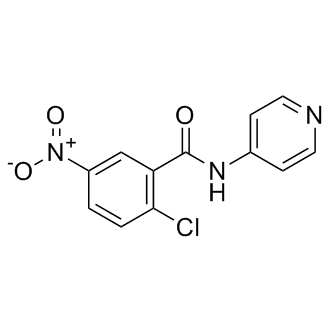| DC49826 |
AZD-9574
|
AZD9574 is a CNS-penetrant, PARP1-selective inhibitor with IC50 of <0.005 μM. AZD9574 demonstrates >10,000-fold selectivity for PARP1 over PARP2 and shows excellent preclinical PK acrossseveral species, with low clearance and high oral bioavailability, and demonstrated in vivo efficacy in a BRCA2−/− DLD-1 mouse xenograft model. |
| DC48270 |
Bocidelpar
|
Bocidelpar is a modulator of peroxisome proliferator-activated receptor delta (PPAR-δ). Bocidelpar improves mitochondrial biogenesis and function in Duchenne Muscular Dystrophy (DMD) muscle cells (extracted from patent WO2017062468A1, compound 2b). |
| DC47176 |
GW 590735
|
GW 590735 is a potent and selective PPARα agonist. GW 590735 showsEC50=4 nM on PPARα and at least 500-fold selectivity versus PPARδ and PPARγ. GW 590735 can be used for the research of dyslipidemia. |
| DC28242 |
15-Deoxy-Δ-12,14-prostaglandin J2
|
15-Deoxy-Δ-12,14-prostaglandin J2 (15d-PGJ2) is a cyclopentenone prostaglandin and a metabolite of PGD2. 15-Deoxy-Δ-12,14-prostaglandin J2 is a selective PPARγ (EC50 of 2 µM) and a covalent PPARδ agonist. 15-Deoxy-Δ-12,14-prostaglandin J2 promotes efficient differentiation of C3H10T1/2 fibroblasts to adipocytes with an EC50 of 7 μM. |
| DC28072 |
Mifobate
|
Mifobate (SR-202) is a potent and specific PPARγ antagonist. Mifobate (SR-202) selectively inhibits Thiazolidinedione (TZD)-induced PPARγ transcriptional activity (IC50=140 μM). Mifobate (SR-202) does not affect basal or ligand-stimulated transcriptional activity of PPARα, PPARβ, or the farnesoid X receptor (FXR). Mifobate (SR-202) shows antiobesity and antidiabetic effects. |
| DC9601 |
T0070907
|
T0070907 is a potent and selective PPARγ antagonist with IC50 of 1 nM; displays > 800-fold selectivity for PPARγ over PPARα and PPARδ. |
| DC11360 |
Pemafibrate
|
Pemafibrate is an orally bioavailable and selective agonist of peroxisome proliferator-activated receptor α (PPARα; EC50 = 1 nM for transcriptional activity), a transcription factor that is essential for regulation of lipid homeostasis. |
| DC2076 |
L-165041
|
L-165041 is a potent PPARδ agonist (Ki = 6 nM). |
| DC7149 |
GW1929
|
GW1929 is a synthetic peroxisome proliferator-activated receptor-γ (PPARγ) agonist with IC50 of 6.2 nM and 13 nM for human and mouse, respectively. |
| DC11750 |
SR-1664
|
SR-1664 is a novel potent, non-agonist PPARγ ligand that blocks the Cdk5-mediated phosphorylation in vitro (IC50=80 nM) and in vivo, without the classical agonism. |






















